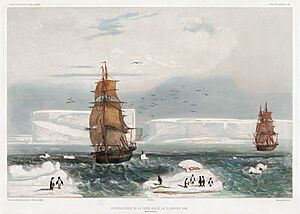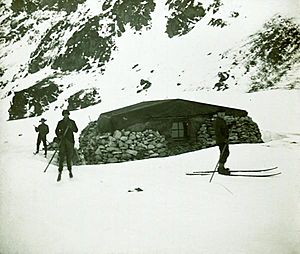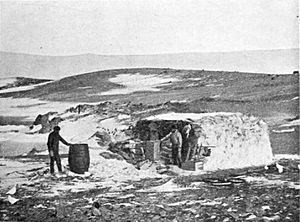Territorial claims in Antarctica facts for kids
Antarctica is a huge continent at the South Pole, mostly covered in ice. Even though it's so far away and cold, seven countries have made claims over parts of it. These countries are Argentina, Australia, Chile, France, New Zealand, Norway, and the United Kingdom. They have set up science stations in their claimed areas. However, other countries like China, India, Japan, and the United States also have research bases there, even though they don't claim any land. Some of these claims overlap, especially between Argentina, Chile, and the United Kingdom.

A Look Back at Antarctic Claims
![]() Spanish Empire 1539–1555
Spanish Empire 1539–1555
- Terra Australis 1539–1555
![]() France 1840–present
France 1840–present
 Adélie Land 1840–present
Adélie Land 1840–present
![]() United Kingdom 1908–present
United Kingdom 1908–present
 Falkland Islands Dependencies 1908–1962
Falkland Islands Dependencies 1908–1962 British Antarctic Territory 1962–present
British Antarctic Territory 1962–present
![]() New Zealand 1923–present
New Zealand 1923–present
 Ross Dependency 1923–present
Ross Dependency 1923–present
![]() Norway 1931–present
Norway 1931–present
 Peter I Island 1931–present
Peter I Island 1931–present Queen Maud Land 1939–present
Queen Maud Land 1939–present
![]() Australia 1933–present
Australia 1933–present
 Australian Antarctic Territory 1933–present
Australian Antarctic Territory 1933–present
![]() Nazi Germany 1939–1945
Nazi Germany 1939–1945
![]() Chile 1940–present
Chile 1940–present
 Chilean Antarctic Territory 1940–present
Chilean Antarctic Territory 1940–present
![]() Argentina 1941–present
Argentina 1941–present
 Argentine Antarctica 1946–present
Argentine Antarctica 1946–present
Early Spanish Claims
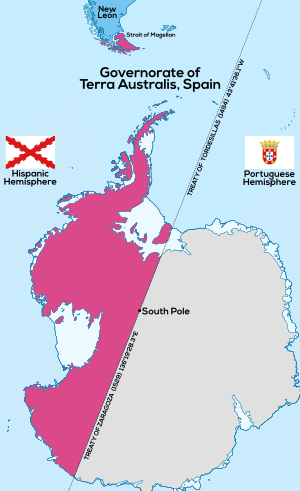
Argentina and Chile believe that Spain was the first country to claim land in Antarctica. In 1539, the King of Spain, Charles V, gave a special order to an explorer named Pedro Sánchez de la Hoz. This order included all lands south of the Strait of Magellan, which meant parts of Antarctica.
This claim was later passed to Pedro de Valdivia in 1540 and then became part of Chile in 1555. Argentina and Chile say that these old Spanish claims, along with agreements like the Treaty of Tordesillas from 1494, show that Spain intended to own these lands. Today, neither Spain nor Portugal claim any part of Antarctica.
British Claims Begin
The United Kingdom has had a presence in the Falkland Islands since 1833. In 1908, the British government officially claimed more land, including South Georgia, the South Orkneys, the South Shetlands, and a part of the Antarctic continent called Graham Land. They said they needed to do this to control and tax the whaling industry in the area.
In 1917, the claim was made even clearer to include all land in a specific wedge-shaped area stretching all the way to the South Pole. The British wanted to include the entire continent in their Empire.
In 1923, a part of Antarctica was given to New Zealand and named the Ross Dependency. Then, in 1933, another large area was given to Australia and called the Australian Antarctic Territory.
Other European Claims
France claimed Adélie Land in 1840 after the French explorer Jules Dumont d'Urville discovered its coastline. He named it after his wife, Adèle, and raised the French flag. The British later agreed to this claim, and the border between Adélie Land and the Australian Antarctic Territory was set in 1938.
Norway also became interested in Antarctica because of its whaling industry. To avoid British taxes, a whale-ship owner named Lars Christensen funded expeditions to claim land for Norway. In 1929, explorers landed on Peter I Island and claimed it for Norway. In 1931, it became an official Norwegian territory.
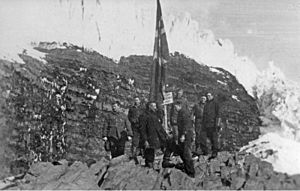
Another expedition in 1929 named a large part of the continent Queen Maud Land after the Norwegian queen. In 1939, Norway officially claimed this land.
Germany also sent an expedition in 1938–1939 to fly over and map parts of Queen Maud Land. They dropped flags with swastikas, but they never made an official claim or built any permanent bases. So, Germany's claim, known as New Swabia, is not recognized today.
South American Involvement
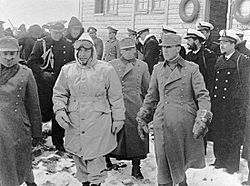
Argentina and Chile have a long history in Antarctica. In 1893, Argentina started giving out licenses for whaling and fishing in Antarctic waters. Chile protested and issued its own rules to protect sea life.
In 1904, Argentina bought a weather station on Laurie Island from a Scottish expedition. This became the Orcadas Base, Argentina's first permanent presence in Antarctica. The British reminded Argentina that the South Orkneys were British territory.
Chile and Argentina tried to agree on their borders in Antarctica in 1906 and 1907, but they couldn't. So, they decided to define their own claims. Chile officially claimed the Chilean Antarctic Territory in 1940, saying it was the heir to Spain's old claims. Argentina formalized its claim in 1946.
In 1943, the British started Operation Tabarin to strengthen their claims and set up permanent bases. They were also worried about other countries, like the United States and Japan, becoming too involved. British personnel even removed Argentine flags from Deception Island.
This British action led Chile to send its own expedition in 1947–48. The Chilean president, Gabriel González Videla, even visited one of the new bases, becoming the first head of state to visit Antarctica.
After World War II
Tensions continued between the United Kingdom and Argentina after the war. In 1952, there was a small incident at Hope Bay. An Argentine team fired a machine gun over the heads of a British team unloading supplies. Argentina later apologized, saying it was a misunderstanding.
The United States also became very interested in Antarctica. From 1939 to 1941, the United States Antarctic Service Expedition set up two bases. After the war, a huge expedition called Operation Highjump (1946–1947) was launched. It involved 4,700 men, 13 ships, and many aircraft. Its main goal was to set up a research base and learn more about the continent.
Moving Towards a Treaty
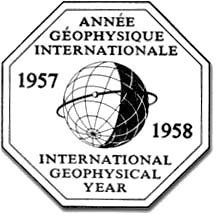
In 1955, the United Kingdom tried to get the International Court of Justice to decide between its claims and those of Argentina and Chile. But both Argentina and Chile refused.
Countries tried to create an international agreement for Antarctica in 1948, but it failed when the Soviet Union showed interest and refused to recognize any claims.
A big step towards peace was the International Geophysical Year (IGY) in 1957–1958. This was a time when scientists from many countries worked together on research in Antarctica. This cooperation showed that countries could work together peacefully on the continent.
Finally, to prevent any military conflicts, the United States, United Kingdom, the Soviet Union, and 9 other countries signed the Antarctic Treaty in 1959. This treaty made Antarctica a place for science and banned military activities. It was the first arms control agreement during the Cold War.
Antarctic Land Claims
Before 1961, seven countries made eight claims to land in Antarctica south of the 60° South line. No people live permanently in these areas.
Most claims are like slices of a pie, except for Peter I Island. The South Orkney Islands are claimed by both Argentina and the United Kingdom. The South Shetland Islands are claimed by Argentina, Chile, and the United Kingdom.
Not all countries recognize each other's claims. The United Kingdom, France, Australia, New Zealand, and Norway recognize each other's claims, as their claims don't overlap.
Official Claims South of 60° S
| Flag | Territory | Claimant | Date | Claim Limits | Area (km2) | |
|---|---|---|---|---|---|---|
| Adélie Land (Part of French Southern and Antarctic Lands) |
1840 | 136°E–142°E | 351,000 | |||
| Argentine Antarctica (Part of Tierra del Fuego Province) |
1946 | 25°W–74°W | 1,461,597 | |||
| Australian Antarctic Territory (External Territory of Australia) |
1933 | 160°E–142°E and 136°E–44°38'E | 5,896,500 | |||
| British Antarctic Territory (British Overseas Territory) |
1908 | 20°W–80°W | 1,709,400 | |||
| Chilean Antarctic Territory (Part of Antártica Chilena Province) |
1940 | 53°W–90°W | 1,250,257.6 | |||
| Peter I Island (Dependency of Norway) |
1931 | 68°51'S 90°35'W | 154 | |||
| Queen Maud Land (Dependency of Norway) |
1939 | 44°38'E–20°W | 2,700,000 | |||
| Ross Dependency (Dependency of New Zealand) |
1923 | 150°W–160°E | 450,000 | |||
| Total Area Claimed | 13,899,908.6 | |||||
Overlapping Claims
|
Unclaimed Land
|
||||||||||||||||
Antarctic Islands North of 60° S
Some islands near Antarctica are not part of the Antarctic Treaty. They are north of the 60° South line. These islands also have no native human population.
 Bouvet Island (Belongs to Norway)
Bouvet Island (Belongs to Norway) French Southern Territories (Belongs to France)
French Southern Territories (Belongs to France) Heard Island and McDonald Islands (Belongs to Australia)
Heard Island and McDonald Islands (Belongs to Australia) Prince Edward Islands (Belongs to South Africa)
Prince Edward Islands (Belongs to South Africa)
Another island group, ![]() South Georgia and the South Sandwich Islands, is a British territory. It is sometimes linked to Antarctica because of its location on tectonic plates.
South Georgia and the South Sandwich Islands, is a British territory. It is sometimes linked to Antarctica because of its location on tectonic plates.
Possible Future Claims
Some countries might make claims in the future. The United States and Russia have said they have the right to do so. Brazil has suggested a way to divide the continent that would give it a claim, which would overlap with Argentina's and Britain's claims.
Peru and Ecuador have also stated their rights to parts of Antarctica based on their closeness and historical links. In 2013, Iran also mentioned that it could claim a part of the South Pole, which would overlap with Australia's claim.
The Antarctic Treaty
The Antarctic Treaty is a special agreement that controls how countries interact with Antarctica. It's the only continent without a native human population. So far, 58 countries have signed this treaty.
The treaty says that:
- Signing it doesn't mean a country gives up any old claims.
- It doesn't change the reasons for claims made before the treaty.
- It doesn't affect a country's right to recognize (or not recognize) other claims.
What the treaty does change is new claims:
- No activities after 1961 can be used to make a claim.
- No new claims can be made.
- No existing claims can be made larger.
Even with the treaty, the United States and Russia still say they have the right to make claims in the future if they want to.
Most claims are like slices of a pie, with their northern border at the 60° South line and their southern point at the South Pole.
See also
- Colonization of Antarctica
- Demographics of Antarctica
- Human outpost
- Research stations in Antarctica
- Territorial claims in the Arctic


